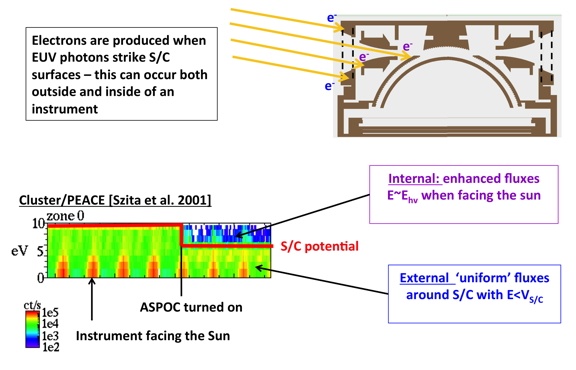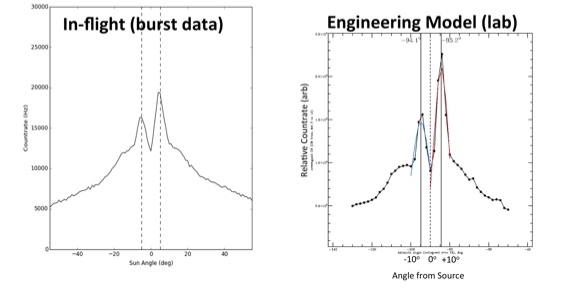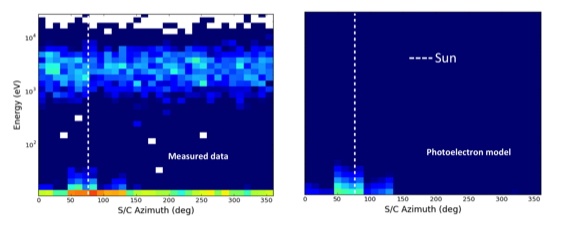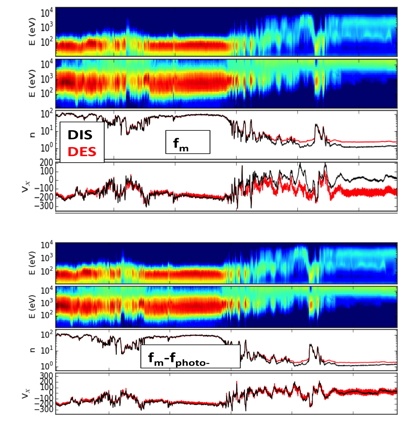Secondary electrons are produced when EUV photons strike spacecraft and instrument surfaces. As shown below in Figure 1, there are two populations of photoelectrons measured at low energies by electron sensors.
- Spacecraft photoelectrons are measured by DES at energies below the spacecraft potential. The spacecraft potential is measured and reported by the electric field double probe. The potential is plasma and spin-phase dependent and approximately uniform across the spacecraft. When the spacecraft controller (ASPOC) is activated, the spacecraft potential decreases as do the energies of spacecraft photoelectrons.
- Secondary electrons produced inside the instrument are measured at low energies independent of ambient plasma or spacecraft potential. The fluxes of these secondary electrons maximize when a given instrument is facing the Sun and are present independent of ASPOC operation.
| Figure 1. (top right) Illustration of photoelectron production in DES. (bottom left) Cluster/PEACE data demonstrate the sensitivity of each population to spacecraft potential (Szita et al. 2001, Cluster PEACE observations of electrons of spacecraft origin, Ann. Geophys.) |
Correcting for Spacecraft Photoelectrons
Assuming a spherically symmetric potential, FPI moments are corrected for spacecraft potential effects. First, instrument measured counts are converted to phase space density at the measured energies. The target energies of these phase space densities are then shifted by the spacecraft potential averaged over a DES (E-Vsc) or DIS (E+Vsc) scan time. Energy channels in DES whose shifted energies become negative (i.e., are below the spacecraft potential) are excluded from the moments integration. In this approach, every FPI scan has a different set of effective energy targets. This approach is equivalent to adjusting phase space densities and using a constant set of energy targets [see Lavraud and Larson 2016, Correcting moments of in situ particle distribution functions for spacecraft electrostatic charging, J. Geophys. Res.: Space Phys.].
Correcting for Internally Generated Photoelectrons
Burst data obtained during commissioning in the hot plasma sheet in the absence of a significant field-aligned electron population were used to characterize the internally generated photoelectrons as a function of energy, deflection state, polar angle, and spinphase. This model is available as a CDF for users interested in estimating the impact of internally generated photoelectrons on their analyses. Photoelectron skymaps [32x16x32] in units of phase space density, denoted as fphoto, are provided as a function of energy table and spacecraft spin phase.
There are subtle changes in the photoelectron fluxes as a function of spacecraft spinphase because the EUV from the Sun has different incident angles to each analyzer. A comparison of the derived photoelectron model with spacecraft data as well as with laboratory testing is shown below in Figure 2. There is a double peak in each analyzer with respect to the angle of incidence of EUV photons due to the large deflection plates used that readily reflect light further into the instrument. The signal from the photoelectrons shown in Figure 3 is measureable up to ~100eV, though is most prominent at the lowest energies (i.e., <50eV).
| Figure 2. (left) Burst data collected on-orbit and (right) laboratory data binned by Sun-instrument angle. Two peaks are observed that correspond to light reflection from DES deflector plates. The asymmetry is caused by asymmetric paths of light into the DES top-hat from the deflectors. |
Figure 3. (left) Measured data during MMS commissioning of photoelectrons. (right) Model of internally generated photoelectrons. Data are uncorrected, pixel averaged, and ordered by spacecraft azimuth and energy. The vertical white line denotes the anti-sunward direction. In the measured data, spacecraft photoelectrons are observed in the low energy channels and hot plasma sheet electrons are observed at ~2keV. The internally generated photoelectrons show multi-peaked structure and spin-phase dependence due to the evolving angles of incidence of the sunlight on each of the 8 DES sensors. |
All observatories exhibit similar behavior such that the same angular structure of the photoelectron model is used for all spacecraft. There is a single tuning factor for each that controls the effective density of the photoelectrons. This tuning factor varies both with time and with spacecraft. The tuning factor was selected for each observatory as a function of time to give Vi,x ~ Ve,x inside the magnetosphere. The tuning factors range from ~0.5-1 and are likely accurate to ±0. 1. These factors are included as global attributes in DES moment CDF files as ‘photo_scale_factor.’ We will refer to this number as nphoto, as it represents the approximate number density of the internally generated photoelectron population.
Integrating the photoelectron model assuming zero spacecraft potential yields an effective number density of nphoto with VX,GSE ~ -700 km/s. The effective moments of the photoelectron model vary with spin phase and spacecraft potential. In the magnetosheath where the number density is >>1 cm-3, the effect of these photoelectrons on plasma moments is often negligible. Inside the magnetosphere, however, where n < 10 cm-3, effects of photoelectrons become significant and need to be taken into account.
Due to the low counting statistics often found at low energies, skymaps (f) are uncorrected for photoelectrons. L2 moments, however, which represent an integral over the entire distribution function are corrected. Here, the appropriately scaled photoelectron model skymaps (nphoto fphoto) are subtracted from the L2 DES skymaps (f) and passed to the moments code, i.e., (f – nphoto fphoto)). This approach simultaneously corrects all moments for photoelectron effects. Because f is a discrete variable with Poisson uncertainties and nphotofphoto is a continuous function, the quantity (f – nphoto fphoto)) can become negative. Although phase space density cannot be less than zero, we allow for negative numbers in the integrand in order to preserve the property ncorrected = nuncorrected - nphoto. When the density of the input plasma is very low (<0.1 cm-3), the DES data is flagged and reliable plasma parameters are not considered to be recoverable.
As mentioned previously, nphoto is included as a global attribute (‘photo_scale_factor’) with DES >V3 moment CDFs. The appropriate fphoto is found as follows:
In the moment/distribution function CDFs for the skymap of interest:
- Determine the energy table tag used for the time period of interest (global attribute ‘stepper_id’, e.g., ‘0-2’) and find the corresponding photoelectron model CDF, e.g., ‘0-2’ -> ‘mms_fpi_brst_l2_des-bgdist_v3.0.0_p0-2.cdf’, ‘mms_fpi_fast_l2_des-bgdist_v3.0.0_p0-2.cdf’.
- For burst mode data, determine the value of steptable_parity for the skymap of interest (record varying). This will be either 0 or 1.
- Determine the value of startdelphi_count_fast or startdelphi_count_brst for the skymap of interest (record varying). This will be a number between 0 and 5760 and is a measure of spacecraft spin-phase (1/16o bins).
In the appropriate photoelectron model CDF:
- Find the index I in the startdelphi_counts_brst or startdelphi_counts_fast array [360 possibilities] whose corresponding value is closest to the measured startdelphi_count_brst or startdelphi_count_fast for the skymap of interest. The closest index can be approximated by I = floor(startdelphi_count_brst/16) or I = floor(startdelphi_count_fast/16)
- For burst data, take fphoto = bgdist_p0_brst or fphoto = bgdist_p1_brst entry with index I for parity 0 and parity 1 data respectively.
- For fast survey data, take fphoto = bgdist_fast with index I. fphoto can now be scaled by nphoto in order to obtain the estimated contribution of photoelectrons to a given skymap. These phase space densities are independent of spacecraft potential.
As shown below for an example magnetopause crossing on August 15, 2015, uncorrected data show a 200km/s antisunward flow inside the magnetosphere. Once corrected for photoelectrons, Vxi ~Vxe ~ 0 km/s inside the magnetosphere. After correction, the electron and ion densities inside the magnetosphere still differ by ~1 cm-3. Populations of electrons and ions outside the FPI energy ranges (10eV-30keV) but traveling at similar bulk velocities to the measured particles may account for this discrepancy. Care should always be taken before interpreting FPI moments from both ion and electrons inside the magnetosphere.
Figure 4. (top panels) Magnetopause crossing data uncorrected for internally generated photoelectrons. An anti-sunward offset of Vx = -200 km/s appears due to the inclusion of photoelectrons in the moment integrals. (bottom panels) The same magnetopause crossing corrected for internally generated photoelectrons using f – nphotofphoto. After correction, Vx,i ~ Vx,e. |
The photoelectron model is available in the “/data/models/fpi” subdirectory at the MMS Science Data Center (https://lasp.colorado.edu/mms/sdc/public/).
Author for this section: Dan Gershman
, , , , , , … (2017). Spacecraft and instrument photoelectrons measured by the dual electron spectrometers on MMS. Journal of Geophysical Research: Space Physics, 122, 11,548–11,558. https://doi.org/10.1002/2017JA024518




